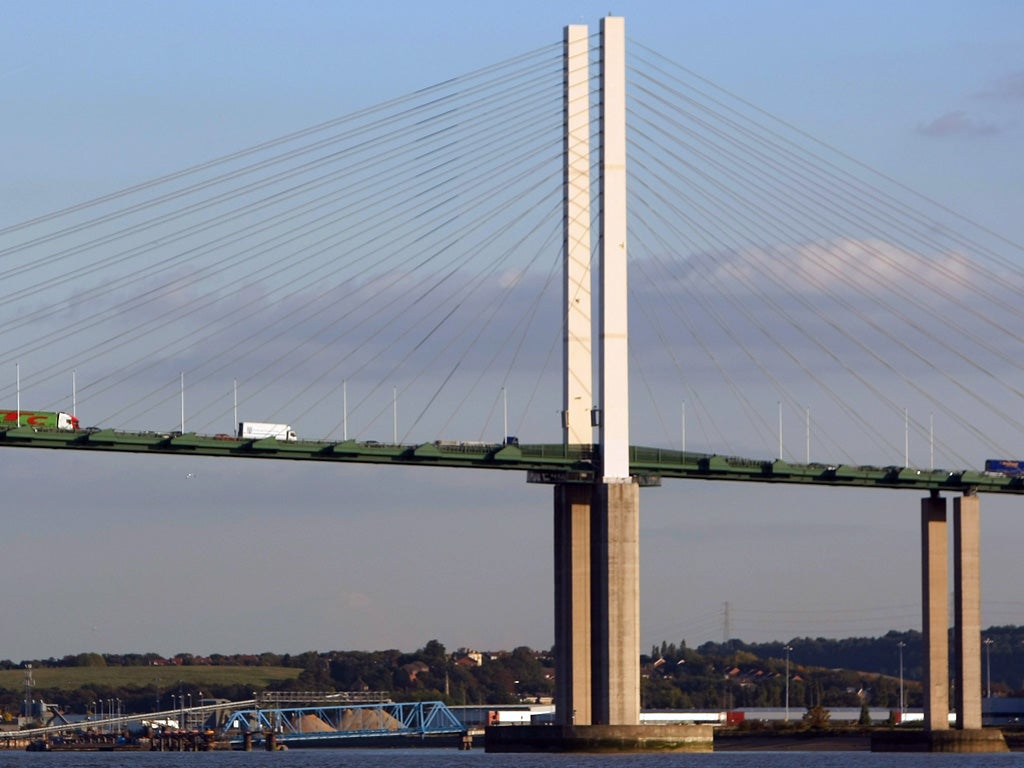£5bn price tag for Thames crossing planned to relieve QEII bridge
One option would pass through undeveloped land that is designated as Green Belt

Your support helps us to tell the story
From reproductive rights to climate change to Big Tech, The Independent is on the ground when the story is developing. Whether it's investigating the financials of Elon Musk's pro-Trump PAC or producing our latest documentary, 'The A Word', which shines a light on the American women fighting for reproductive rights, we know how important it is to parse out the facts from the messaging.
At such a critical moment in US history, we need reporters on the ground. Your donation allows us to keep sending journalists to speak to both sides of the story.
The Independent is trusted by Americans across the entire political spectrum. And unlike many other quality news outlets, we choose not to lock Americans out of our reporting and analysis with paywalls. We believe quality journalism should be available to everyone, paid for by those who can afford it.
Your support makes all the difference.Options for a new River Thames road crossing include a scheme that would pass through "environmentally sensitive areas" and could cost as much £5 billion, the Government revealed today.
This scheme - one of three options now out for public consultation - could see the building of a new road linking the M25 north of the Thames in Essex with the M2 south of the river in Kent.
The longest of the three options, this Option C route will pass through undeveloped land that is designated as Green Belt.
The consultation document released today went on: "A route at this location would also pass through environmentally sensitive areas, including the Kent Downs Area of Outstanding Natural Beauty, ancient woodland and the Thames Marshes Ramsar site, where development would need to be proven to be of "overriding public interest" before it could go ahead.
"Overall, Option C would result in the greatest impacts on environmentally sensitive areas of all the options."
The Option C capital cost would be between £3.1 billion and £3.2 billion.
There is also a variant to Option C which would include the widening of the A229 between the M2 and the M20 in Kent, effectively providing a new direct link road from the M25 all the way south to the M20.
The capital cost of this variant would be between £4.9 billion and £5.0 billion.
Announced today by Roads Minister Stephen Hammond, the other two options are:
* Option A - a crossing at the site of the existing A282 Dartford-Thurrock crossing that links the M25 north of the river in Essex with the M25 south of the Thames in Kent.
* Option B - Connecting the A2 Swanscombe Peninsula in Kent with the A1089 in Essex.
Option A's capital cost is between £1.2 billion and £1.8 billion, while Option B's capital cost is between £1.8 billion and £2.2 billion.
The consultation document said that as Option C and the Option C variant costs were so much greater than for the other options, "this may mean that any revenues received from crossing users are not sufficient to meet the total project costs over the projected length of the project concession".
It went on: "Additional financial support may therefore be required from public finances in the event that the Government chooses to develop Option C or the Option C variant."
The document said that each location option was likely to be feasible to deliver, in terms of construction, value for money and financing and that each location option had been shown to reduce congestion at the existing crossing, albeit to varying extents.
Mr Hammond said today: "With traffic levels expected to increase by a fifth over the next 30 years, it is vital we take action now on the future of a new Lower Thames crossing to make sure that our road network is able to meet the future economic needs of the country."
He went on: "There are some tough decisions to be made, but this is the first step in making sure that the residents, businesses and motorists who rely on the crossing receive the service they expect and deserve in the years to come.
"I encourage anyone who uses the existing crossing or has an interest in the location of the new crossing to let us have their views on these proposals. This will enable us to make the right decision on the location of the new crossing."
RAC Foundation director Professor Stephen Glaister said: "This is a critical crossing on one of the busiest routes in the country, if not the continent.
"Yet much of the congestion is of the Government's own making thanks to the archaic toll booths which routinely bring traffic to a standstill. The introduction of the long-discussed free-flow payment system will help, but it is welcome that ministers are looking to the future and recognise that traffic is set to increase significantly."
He went on: "The big question is how the scheme will be funded. As with the existing crossing the suspicion will be that drivers will pay for any extra capacity through charges - charges which will remain in place long after the project is paid for."
Freight Transport Association road network management policy head Malcolm Bingham said: "There is absolutely no doubt that improving capacity and easing congestion at Dartford is essential, but we have to ensure that the best option is selected, providing real relief on this important national artery."
PA
Join our commenting forum
Join thought-provoking conversations, follow other Independent readers and see their replies
Comments